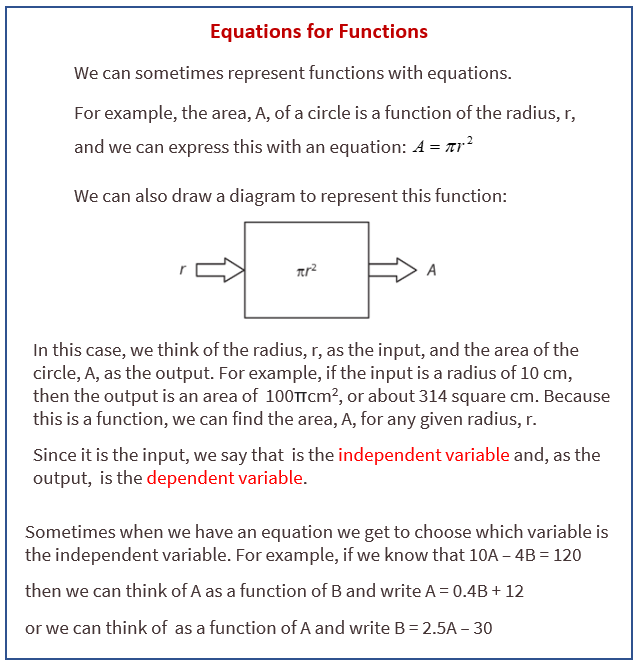Illustrative Mathematics Grade 8, Unit 5, Lesson 3: Equations for Functions
Learning Targets:
- I can find the output of a function when I know the input.
- I can name the independent and dependent variables for a given function and represent the function with an equation.
Related Pages
Illustrative Math
Grade 8
Lesson 3: Equations for Functions
Let’s find outputs from equations.
Illustrative Math Unit 8.5, Lesson 3 (printable worksheets)
Lesson 3 Summary
The following diagram shows how to name the independent and dependent variables for a given function and represent the function with an equation.

Lesson 3.1 A Square’s Area
Fill in the table of input-output pairs for the given rule. Write an algebraic expression for the rule in the box in the diagram.
Lesson 3.2 Diagrams, Equations, and Descriptions
Record your answers to these questions in the table provided:
- Match each of these descriptions with a diagram:
a. the circumference, C, of a circle with radius,r
b. the distance in miles, d, that you would travel in t hours if you drive at 60 miles per hour
c. the output when you triple the input and subtract 4
d. the volume of a cube, v, given its edge length, s - Write an equation for each description that expresses the output as a function of the input.
- Find the output when the input is 5 for each equation.
- Name the independent and dependent variables of each equation.
Are you ready for more?
Choose a 3-digit number as an input and apply the following rule to it, one step at a time:
- Multiply your number by 7.
- Add one to the result.
- Multiply the result by 11.
- Subtract 5 from the result.
- Multiply the result by 13
- Subtract 78 from the result to get the output.
Can you describe a simpler way to describe this rule? Why does this work?
-
Show Answer
13((11(7x + 1)) - 5) - 78
= 1001x
-
Show Answer
Lesson 3.3 Dimes and Quarters
Jada had some dimes and quarters that had a total value of $12.50. The relationship between the number of dimes, d, and the number of quarters, q, can be expressed by the equation 0.1d + 0.25q = 12.5.
- If Jada has 4 quarters, how many dimes does she have?
- If Jada has 10 quarters, how many dimes does she have?
- Is the number of dimes a function of the number of quarters? If yes, write a rule (that starts with d = …) that you can use to determine the output, d, from a given input, q. If no, explain why not.
- If Jada has 25 dimes, how many quarters does she have?
- If Jada has 30 dimes, how many quarters does she have?
- Is the number of quarters a function of the number of dimes? If yes, write a rule (that starts with q=…) that you can use to determine the output, q, from a given input, d. If no, explain why not.
Lesson 3 Practice Problems
- Here is an equation that represents a function: 72x + 12y = 60. Select all the different equations that describe the same function:
- a. Graph a system of linear equations with no solutions.
b. Write an equation for each line you graph. - Brown rice costs $2 per pound, and beans cost $1.60 per pound. Lin has $10 to spend on these items to make a large meal of beans and rice for a potluck dinner. Let b be the number of pounds of beans Lin buys and r be the number of pounds of rice she buys when she spends all her money on this meal.
a. Write an equation relating the two variables.
b. Rearrange the equation so b is the independent variable.
c. Rearrange the equation so r is the independent variable. - Solve each equation and check your answer.
The Open Up Resources math curriculum is free to download from the Open Up Resources website and is also available from Illustrative Mathematics.
Try out our new and fun Fraction Concoction Game.
Add and subtract fractions to make exciting fraction concoctions following a recipe. There are four levels of difficulty: Easy, medium, hard and insane. Practice the basics of fraction addition and subtraction or challenge yourself with the insane level.

We welcome your feedback, comments and questions about this site or page. Please submit your feedback or enquiries via our Feedback page.